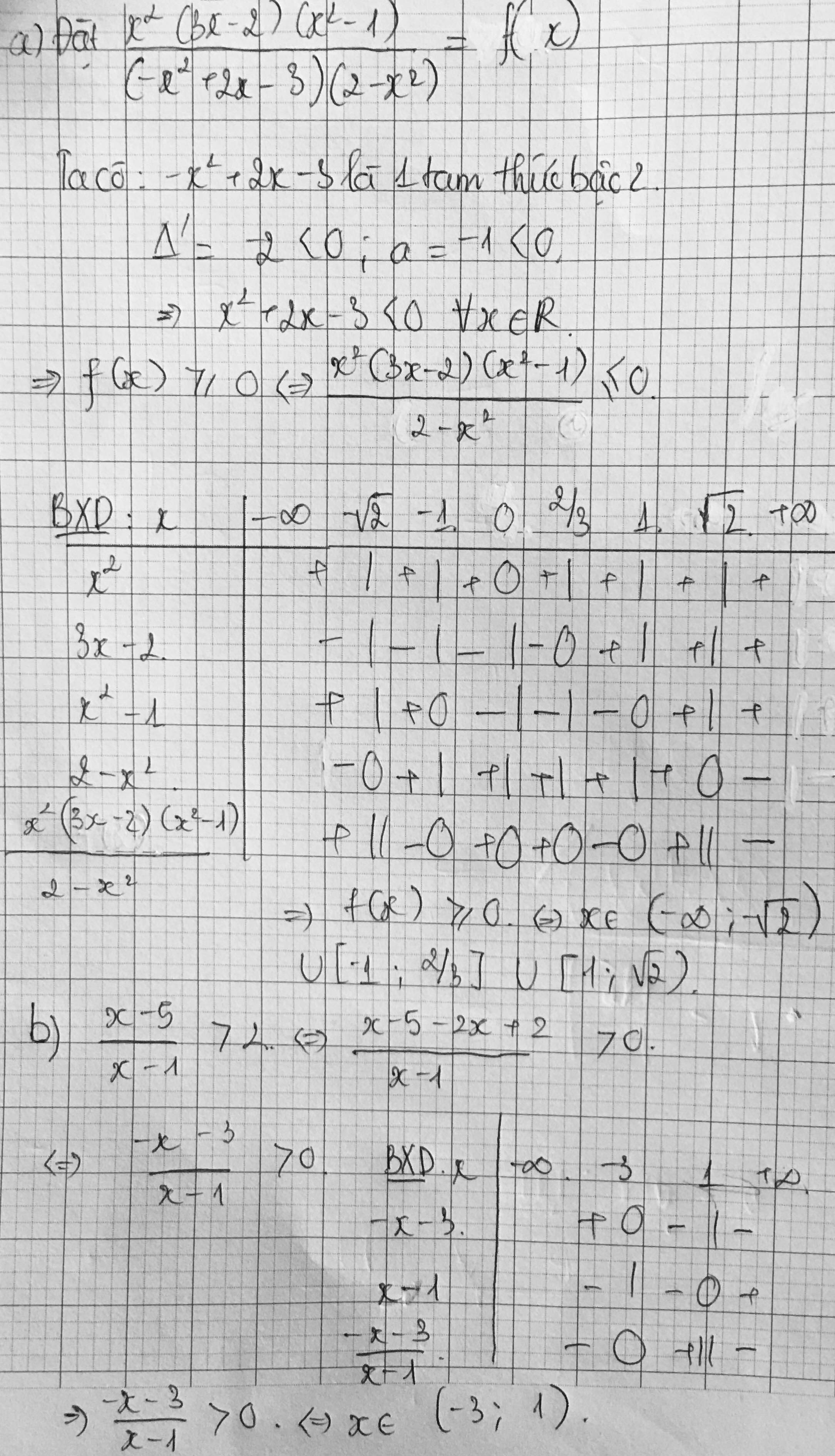Hãy nhập câu hỏi của bạn vào đây, nếu là tài khoản VIP, bạn sẽ được ưu tiên trả lời.

a:
ĐKXĐ: x>=5/2
\(\sqrt{x-2+\sqrt{2x-5}}+\sqrt{x+2+3\sqrt{2x-5}}=7\sqrt{2}\)
=>\(\sqrt{2x-4+2\sqrt{2x-5}}+\sqrt{2x+4+6\cdot\sqrt{2x-5}}=14\)
=>\(\sqrt{\left(\sqrt{2x-5}+1\right)^2}+\sqrt{\left(\sqrt{2x-5}+3\right)^2}=14\)
=>\(\sqrt{2x-5}+1+\sqrt{2x-5}+3=14\)
=>\(2\sqrt{2x-5}+4=14\)
=>\(\sqrt{2x-5}=5\)
=>2x-5=25
=>2x=30
=>x=15
b: \(x^2-4x=\sqrt{x+2}\)
=>\(x+2=\left(x^2-4x\right)^2\) và x^2-4x>=0
=>x^4-8x^3+16x^2-x-2=0 và x^2-4x>=0
=>(x^2-5x+2)(x^2-3x-1)=0 và x^2-4x>=0
=>\(\left[{}\begin{matrix}x=\dfrac{5+\sqrt{17}}{2}\\x=\dfrac{3-\sqrt{13}}{2}\end{matrix}\right.\)

ĐKXĐ: \(x\ge\dfrac{1}{5}\)
\(\Leftrightarrow2x^2+x-3+2x-\sqrt{5x-1}+\sqrt[3]{x-9}+2\le0\)
\(\Leftrightarrow\left(x-1\right)\left(2x+3\right)+\dfrac{4x^2-5x+1}{2x+\sqrt{5x-1}}+\dfrac{x-1}{\sqrt[3]{\left(x-9\right)^2}-2\sqrt[3]{x-9}+4}\le0\)
\(\Leftrightarrow\left(x-1\right)\left(2x+3+\dfrac{4x-1}{2x+\sqrt{5x-1}}+\dfrac{1}{\sqrt[3]{\left(x-9\right)^2}-2\sqrt[3]{x-9}+4}\right)\le0\)
\(\Leftrightarrow x-1\le0\)
\(\Rightarrow\dfrac{1}{5}\le x\le1\)

1.ĐK: \(x\ge\dfrac{1}{4}\)
bpt\(\Leftrightarrow5x+1+4x-1-2\sqrt{20x^2-x-1}< 9x\)
\(\Leftrightarrow2\sqrt{20x^2-x-1}>0\)
\(\Leftrightarrow20x^2-x-1>0\)
\(\Leftrightarrow\left[{}\begin{matrix}x< \dfrac{-1}{5}\\x>\dfrac{1}{4}\end{matrix}\right.\)
2.ĐK: \(-2\le x\le\dfrac{5}{2}\)
bpt\(\Leftrightarrow x+2+3-x-2\sqrt{-x^2+x+6}< 5-2x\)
\(\Leftrightarrow2x< 2\sqrt{-x^2+x+6}\)
\(\Leftrightarrow x^2< -x^2+x+6\)
\(\Leftrightarrow-2x^2+x+6>0\)
\(\Leftrightarrow\dfrac{-3}{2}< x< 2\)
3. ĐK: \(\left\{{}\begin{matrix}12+x-x^2\ge0\\x\ne11\\x\ne\dfrac{9}{2}\end{matrix}\right.\)
.bpt\(\Leftrightarrow\sqrt{12+x-x^2}\left(\dfrac{1}{x-11}-\dfrac{1}{2x-9}\right)\ge0\)
\(\Leftrightarrow\sqrt{-x^2+x+12}.\dfrac{x+2}{\left(x-11\right)\left(2x-9\right)}\ge0\)
\(\Rightarrow\dfrac{x+2}{\left(x-11\right)\left(2x-9\right)}\ge0\)
\(\Leftrightarrow\dfrac{x+2}{2x^2-31x+99}\ge0\)
*Xét TH1: \(\left\{{}\begin{matrix}x+2\ge0\\2x^2-31x+99>0\end{matrix}\right.\)\(\Leftrightarrow\left\{{}\begin{matrix}x\ge-2\\\left[{}\begin{matrix}x< \dfrac{9}{2}\\x>11\end{matrix}\right.\end{matrix}\right.\)\(\Leftrightarrow\left[{}\begin{matrix}-2\le x< \dfrac{9}{2}\\x>11\end{matrix}\right.\)
*Xét TH2: \(\left\{{}\begin{matrix}x+2\le0\\2x^2-31x+99< 0\end{matrix}\right.\)\(\Leftrightarrow\left\{{}\begin{matrix}x\le-2\\\dfrac{9}{2}< x< 11\end{matrix}\right.\)\(\Rightarrow\dfrac{9}{2}< x< 11\)

Để giải các phương trình này, chúng ta sẽ làm từng bước như sau: 1. 13x(7-x) = 26: Mở ngoặc và rút gọn: 91x - 13x^2 = 26 Chuyển về dạng bậc hai: 13x^2 - 91x + 26 = 0 Giải phương trình bậc hai này để tìm giá trị của x. 2. (4x-18)/3 = 2: Nhân cả hai vế của phương trình với 3 để loại bỏ mẫu số: 4x - 18 = 6 Cộng thêm 18 vào cả hai vế: 4x = 24 Chia cả hai vế cho 4: x = 6 3. 2xx + 98x2022 = 98x2023: Rút gọn các thành phần: 2x^2 + 98x^2022 = 98x^2023 Chia cả hai vế cho 2x^2022: x + 49 = 49x Chuyển các thành phần chứa x về cùng một vế: 49x - x = 49 Rút gọn: 48x = 49 Chia cả hai vế cho 48: x = 49/48 4. (x+1) + (x+3) + (x+5) + ... + (x+101): Đây là một dãy số hình học có công sai d = 2 (do mỗi số tiếp theo cách nhau 2 đơn vị). Số phần tử trong dãy là n = 101/2 + 1 = 51. Áp dụng công thức tổng của dãy số hình học: S = (n/2)(a + l), trong đó a là số đầu tiên, l là số cuối cùng. S = (51/2)(x + (x + 2(51-1))) = (51/2)(x + (x + 100)) = (51/2)(2x + 100) = 51(x + 50) Vậy, kết quả của các phương trình là: 1. x = giá trị tìm được từ phương trình bậc hai. 2. x = 6 3. x = 49/48 4. S = 51(x + 50)

a.
\(3\sqrt{-x^2+x+6}\ge2\left(1-2x\right)\)
\(\Leftrightarrow\left[{}\begin{matrix}\left\{{}\begin{matrix}-x^2+x+6\ge0\\1-2x< 0\end{matrix}\right.\\\left\{{}\begin{matrix}1-2x\ge0\\9\left(-x^2+x+6\right)\ge4\left(1-2x\right)^2\end{matrix}\right.\end{matrix}\right.\)
\(\Leftrightarrow\left[{}\begin{matrix}\left\{{}\begin{matrix}-2\le x\le3\\x>\dfrac{1}{2}\end{matrix}\right.\\\left\{{}\begin{matrix}x\le\dfrac{1}{2}\\25\left(x^2-x-2\right)\le0\end{matrix}\right.\end{matrix}\right.\)
\(\Leftrightarrow\left[{}\begin{matrix}\dfrac{1}{2}< x\le3\\\left\{{}\begin{matrix}x\le\dfrac{1}{2}\\-1\le x\le2\end{matrix}\right.\end{matrix}\right.\)
\(\Rightarrow-1\le x\le3\)
b.
ĐKXĐ: \(x\ge0\)
\(\Leftrightarrow\sqrt{2x^2+8x+5}-4\sqrt{x}+\sqrt{2x^2-4x+5}-2\sqrt{x}=0\)
\(\Leftrightarrow\dfrac{2x^2+8x+5-16x}{\sqrt{2x^2+8x+5}+4\sqrt{x}}+\dfrac{2x^2-4x+5-4x}{\sqrt{2x^2-4x+5}+2\sqrt{x}}=0\)
\(\Leftrightarrow\dfrac{2x^2-8x+5}{\sqrt{2x^2+8x+5}+4\sqrt{x}}+\dfrac{2x^2-8x+5}{\sqrt{2x^2-4x+5}+2\sqrt{x}}=0\)
\(\Leftrightarrow\left(2x^2-8x+5\right)\left(\dfrac{1}{\sqrt{2x^2+8x+5}+4\sqrt{x}}+\dfrac{1}{\sqrt{2x^2-4x+5}+2\sqrt{x}}\right)=0\)
\(\Leftrightarrow2x^2-8x+5=0\)
\(\Leftrightarrow x=\dfrac{4\pm\sqrt{6}}{2}\)

a) \(\sqrt {3{x^2} - 4x - 1} = \sqrt {2{x^2} - 4x + 3} \)
Bình phương hai vế của phương trình ta được:
\(\begin{array}{l}3{x^2} - 4x - 1 = 2{x^2} - 4x + 3\\ \Leftrightarrow {x^2} = 4\end{array}\)
\( \Leftrightarrow x = 2\) hoặc \(x = - 2\)
Thay lần lượt các giá trị này vào phương trình đã cho, ta thấy cả 2 giá trị x=2; x=-2 thỏa mãn
Vậy tập nghiệm của phương trình là \(S = \left\{ { - 2;2} \right\}\)
b) \(\sqrt {{x^2} + 2x - 3} = \sqrt { - 2{x^2} + 5} \)
Bình phương hai vế của phương trình ta được:
\(\begin{array}{l}{x^2} + 2x - 3 = - 2{x^2} + 5\\ \Leftrightarrow 3{x^2} + 2x - 8 = 0\end{array}\)
\( \Leftrightarrow x = - 2\) hoặc \(x = \frac{4}{3}\)
Thay lần lượt các giá trị này vào phương trình đã cho, ta thấy chỉ có giá trị \(x = \frac{4}{3}\) thỏa mãn
Vậy tập nghiệm của phương trình là \(x = \frac{4}{3}\)
c) \(\sqrt {2{x^2} + 3x - 3} = \sqrt { - {x^2} - x + 1} \)
Bình phương hai vế của phương trình ta được:
\(\begin{array}{l}2{x^2} + 3x - 3 = - {x^2} - x + 1\\ \Leftrightarrow 3{x^2} + 4x - 4\end{array}\)
\( \Leftrightarrow x = - 2\) hoặc \(x = \frac{2}{3}\)
Thay lần lượt các giá trị này vào phương trình đã cho, ta thấy cả 2 giá trị đều không thỏa mãn.
Vậy phương trình vô nghiệm
d) \(\sqrt { - {x^2} + 5x - 4} = \sqrt { - 2{x^2} + 4x + 2} \)
Bình phương hai vế của phương trình ta được:
\(\begin{array}{l} - {x^2} + 5x - 4 = - 2{x^2} + 4x + 2\\ \Leftrightarrow {x^2} + x - 6 = 0\end{array}\)
\( \Leftrightarrow x = - 3\) hoặc \(x = 2\)
Thay lần lượt các giá trị này vào phương trình đã cho, ta thấy x=2 thỏa mãn.
Vậy nghiệm của phương trình là x = 2.
